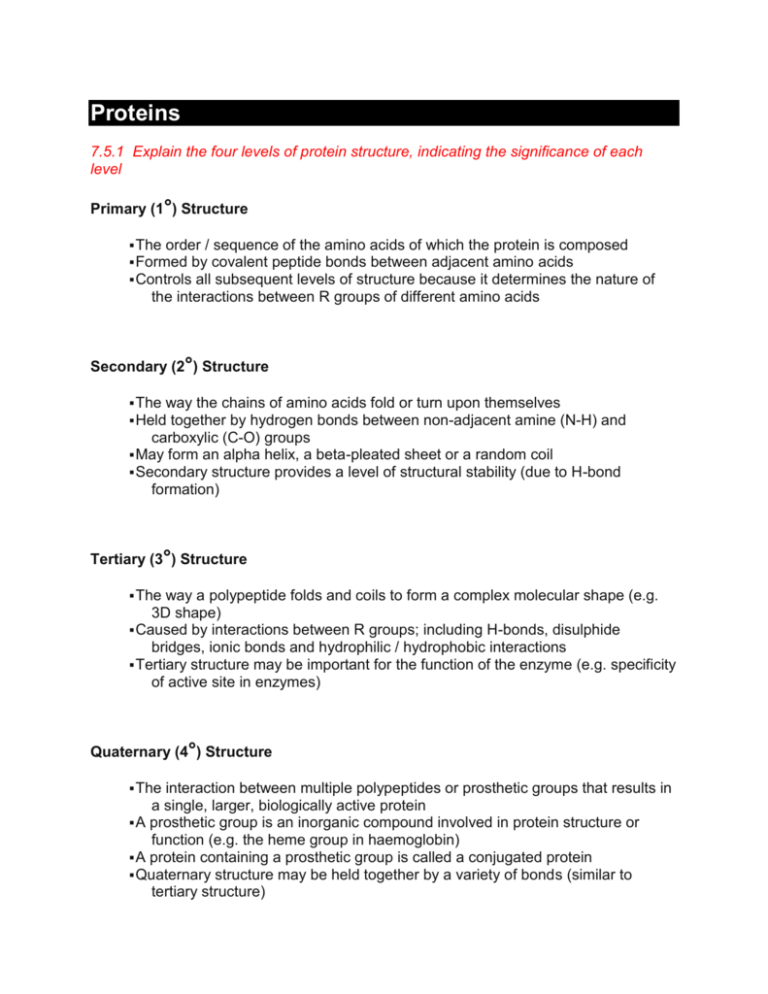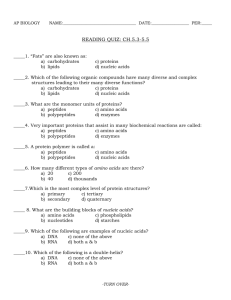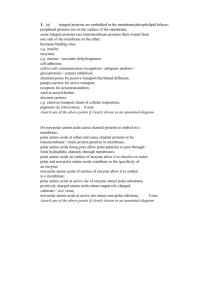Proteins
advertisement

Proteins 7.5.1 Explain the four levels of protein structure, indicating the significance of each level Primary (1°) Structure The order / sequence of the amino acids of which the protein is composed Formed by covalent peptide bonds between adjacent amino acids Controls all subsequent levels of structure because it determines the nature of the interactions between R groups of different amino acids Secondary (2°) Structure The way the chains of amino acids fold or turn upon themselves Held together by hydrogen bonds between non-adjacent amine (N-H) and carboxylic (C-O) groups May form an alpha helix, a beta-pleated sheet or a random coil Secondary structure provides a level of structural stability (due to H-bond formation) Tertiary (3°) Structure The way a polypeptide folds and coils to form a complex molecular shape (e.g. 3D shape) Caused by interactions between R groups; including H-bonds, disulphide bridges, ionic bonds and hydrophilic / hydrophobic interactions Tertiary structure may be important for the function of the enzyme (e.g. specificity of active site in enzymes) Quaternary (4°) Structure The interaction between multiple polypeptides or prosthetic groups that results in a single, larger, biologically active protein A prosthetic group is an inorganic compound involved in protein structure or function (e.g. the heme group in haemoglobin) A protein containing a prosthetic group is called a conjugated protein Quaternary structure may be held together by a variety of bonds (similar to tertiary structure) Levels of Protein Organisation 7.5.2 Outline the difference between fibrous and globular proteins, with reference to two examples of each protein type 7.5.3 Explain the significance of polar and non-polar amino acids Polar amino acids have hydrophilic R groups, whereas non-polar amino acids have hydrophobic R groups For water soluble proteins, non-polar amino acids tend to be found in the centre of the protein (stabilising structure) while polar amino acids are found on the surface (capable of interacting with water molecules) For membrane-bound proteins, non-polar amino acids tend to be localised on the surface in contact with the membrane, while polar amino acids line interior pores (to create hydrophilic channels) For enzymes, the active site specifically depends on the location and distribution of polar and non-polar amino acids as hydrophobic and hydrophilic interactions can play a role in substrate binding to the active site 7.5.4 State four functions of proteins, giving a named example of each Structure: Support for body tissue (e.g. collagen, elastin, keratin) Hormones: Regulation of blood glucose (e.g. insulin, glucagon) Immunity: Bind antigens (e.g. antibodies / immunoglobulins) Transport: Oxygen transport (e.g. haemoglobin, myoglobin) Movement: Muscle contraction (e.g. actin / myosin, troponin / tropomyosin) Enzymes: Speeding up metabolic reactions (e.g. catalase, lipase, pepsin)











